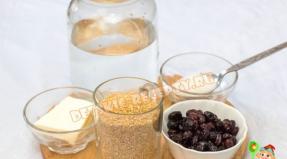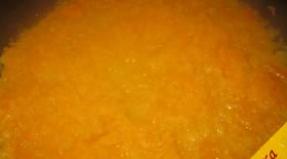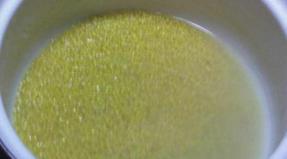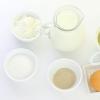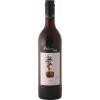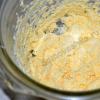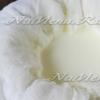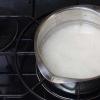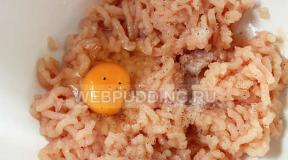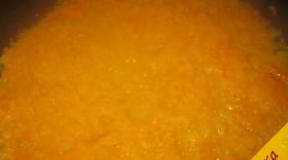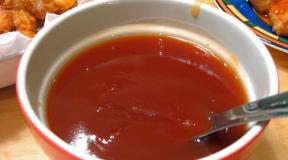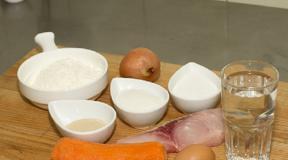What can you cook with milk powder? Powdered milk desserts
Prepare products for the test. I doubled the amount of ingredients and made a pie with a diameter of 26 cm.
Combine eggs with sugar in a convenient mixing bowl.
Using a mixer, beat the eggs with sugar into a fluffy mass. I beat the eggs for 3-4 minutes.
Then add the sifted flour and baking powder into the egg mixture and mix with a silicone spatula.
Sift the milk powder into the resulting mixture and add vanilla sugar.
Mix the dough thoroughly with a silicone spatula until smooth. The dough will not be thick, like condensed milk.
Grease a baking pan with vegetable oil and pour the dough into the pan. Place the pan with the dough in a cold oven.
Turn on the oven at 200 degrees and bake the cake mixed with milk powder for about 30-35 minutes until the toothpick is dry. The cake will become a beautiful golden color and increase in volume.
Cool the baked goods slightly in the pan, then remove and cut into pieces. Pie made from dough made with milk powder turns out very tasty and will probably be liked by many.
Powdered milk is an infrequent guest in our kitchen cabinets. And in vain, dear subscribers! This product can be used not only for its intended purpose (read - diluted with water and drunk). It produces milk that is many times healthier than store-bought ones. Moreover, some homemade treats made with powdered milk you can eat it even on a diet.
Editorial "With taste" I have collected 5 simple recipes for sweets made from powdered milk for you. Diet marshmallows, “truffles” and even dry coffee creamer - you will spend no more than 15 minutes on each recipe, and the end result will be pure deliciousness without preservatives, thickeners or flavors.
What can be made from milk powder
First of all, which powder to choose? We recommend skim milk powder because it dissolves better and faster than whole milk. The latter needs to be diluted only with warm water, but even then it can become lumpy.
If you lactose intolerant, you can replace regular milk powder with coconut, goat or rice milk - also in powder. They can be found in specialized stores.
Now let's move on to the recipes!

This dry preparation is more practical than liquid cream, because it is stored much longer, does not contain chemicals and softens your favorite drink just as gently.
You will need:
- 1 cup powdered sugar (half a cup for moderate sweetness, 2 cups for intense sweetness)
- 4 cups milk powder
- 3 tbsp. l. liquid coconut oil
- 1 tbsp. l. cocoa or vanilla powder, optional
Mix all ingredients thoroughly and pour into an airtight container or glass jar. Store in a dark, dry place.

You will need:
- 1 glass of milk powder
- 4 tbsp. l. butter at room temperature
- 0.5 tsp. vanilla extract
- a third of a glass of boiling water
- 150 mg sugar
Beat all ingredients (except milk powder) thoroughly with a mixer. Finally, add the dry mixture and mix again at medium speed. Ready! This mixture can be stored in the refrigerator for no longer than a week. Although condensed milk rarely “survives” more than two tea parties, especially with pancakes.

You will need:
- 0.5 cups milk powder
- 0.5 cups ice water
- a couple drops of vanilla extract
Let us immediately note: the number of components is individual and depends on how much of the final product you need. The main thing is to maintain the proportions 1:1.
To make homemade milk, beat the milk powder and water with a mixer at maximum speed. When fluffy foam forms, add a drop of vanilla extract into it and continue whisking the mixture until thick.

You will need:
- 1 egg white
- 0.5 tbsp. l. gelatin
- 0.5 glasses of water
- 1.5 tbsp. l. skim milk powder
- sweetener to taste
- vanillin to taste
- Soak the gelatin in water at room temperature for half an hour. Heat the swollen mixture over low heat until completely dissolved, but do not bring to a boil. Add sweetener, vanilla and stir.
- In a separate bowl, beat the chilled egg whites until stiff. Now spoon the mixture into the gelatin, whisking continuously with a mixer for 2-3 minutes.
- Cover a plate or board with parchment, sprinkle it with dry milk, quickly lay out the finished gelatinous mass and form a tall rectangle. Sprinkle the marshmallows with the remaining dry milk through a sieve and refrigerate for 1.5–2 hours.
- Cut the finished marshmallows into squares and serve.
Calorie content per 100 g of product- 119 kcal.
Milk is a very nutritious liquid that people of any age cannot do without. Due to the individual characteristics of the body, not everyone can consume cow's or goat's milk. To get rid of such problems, milk powder was created, which can be successfully used in cooking, but for this you need to know exactly how to make a ready-to-drink liquid from the dry mixture.

Compound
Powdered milk is a natural product, and it is obtained using the technology of drying cow's milk in specialized machines. The advantage of this process is that the dry powder weighs much less and lasts much longer. For the powdered composition, you do not need to create special conditions or store it in the refrigerator, like regular milk. The bag will be perfectly stored for up to six months in a dry place in the kitchen. If in rural areas it is quite easy to get natural milk directly from a cow or goat, then in big cities this becomes a real problem, and store-bought goods are significantly different from rural ones.
Drying whole milk allows everyone to have an unlimited supply of milk at home, which will not turn sour, to which there will be no allergies, and which will always be at hand. There is no doubt about the naturalness of the product, since only cow’s milk is used for preparation, which is subject to condensation and drying at temperatures up to 170 degrees in special machines, after which it is packaged and served on store shelves. This option for processing the product was developed back in the 19th century, where people were already interested in increasing the shelf life of this liquid.
Typically, the calorie content of the product is 550 kcal per 100 grams, but if skim milk is used, it is reduced to 370 kcal.
It contains many useful substances, including:
- vitamins A, B1, B2, B9, B12, D, C, PP, E;
- micro- and macroelements - sodium, phosphorus, calcium, potassium, magnesium, cobalt, selenium, manganese, sulfur, iodine, iron, etc.;
- a set of the most important amino acids for the human body.

The composition of milk powder may vary depending on its variety.
- Whole contains the highest percentage of fat content, therefore it is the most nutritious for the human body. Due to this feature, this option has the shortest shelf life of the product. Most often, people try to use this particular variety to prepare a variety of dishes.
- Low fat. To prepare it, whole milk is taken, but excess fat is additionally removed from it, after which it is dried to a powder state. Such a finished product has almost no fat, and this makes it possible to store it for almost 9 months. Skim milk powder is often used to make cheese and is added to bread, meat and pastries.
- Instant. The composition of such a powder contains the previous components mixed together, then moistened and dried again. Such milk is of great importance in the production of baby food and products that must be prepared very quickly.
In milk powder, 50% is carbohydrates, and the rest is divided between proteins and minerals.


Nuances of preparation
To get regular milk from dry milk, you need to return it to its original state by adding water. To properly dilute the mixture, you need to strive for a 3:1 ratio, where there should be more water than milk. So, for 1 liter of water on average you need 300-350 grams of powder. It is best to use warm water for this, as the mixture will dissolve faster. For different purposes, the proportions of the above components may differ.
To do everything right, it is important to follow these recommendations.
- It will be much easier to dissolve powdered milk in warm water, because when cold, part of the composition will dissolve, and part will form crystals that will be felt while drinking.
- It will also not be possible to prepare regular milk from powdered milk if the water is too hot. The powder will begin to coagulate when exposed to boiling water.
- The correct sequence for preparing regular milk from powdered milk at home is to gradually add water to the powder, and not vice versa, otherwise it will not be possible to make a lump-free product.
- Using a mixer when preparing milk would be undesirable because it creates unnecessary foam.
- After the milk has been prepared, it is necessary to give some time for its particles to completely dissolve and obtain a completely finished drink.


Not everyone knows that you can use powdered milk just like regular milk, and its benefits are not lost. Reconstituted milk is practically in no way inferior to whole milk, so you should not be afraid to eat it. The only difference in these products will be the nutritional value, which is lower in the dry variety than in the regular one. An important nuance is that if you are allergic to lactose, a person should not consume milk in any form.
When buying dry powder, it is important to read the composition of the product and make sure that it does not contain vegetable fats, which are often used to replace milk fat by unscrupulous manufacturers. In addition to the fact that the resulting composition will be devoid of beneficial qualities, it can also be dangerous to human health.
Most often in stores you can see the following product options:
- whole milk powder, which is sold in 200 gram packages;
- low fat, packaged in 250 grams;
- 26% fat content, which can be found in 400 gram packages.
Depending on the purpose of use, you can select both the type and packaging of the composition, from which, with the help of simple manipulations, it is possible to obtain the desired result.



Technology
Due to the fact that for different cooking tasks it is necessary to use different proportions of water and milk powder, It is important to know exactly the specifics of the process.
- To get a liter of regular milk, the fat content of which will be about 3%, you need to take 8 teaspoons of powder. If you need to achieve a less fatty product (no more than 2.6%), then only 6 spoons are added.
- When the optimal amount of powder has been prepared, you need to stock up on water, the temperature of which should not exceed 60 degrees.
- The powder should be in a deep container, into which heated water is then poured. It is important to do this slowly, stirring the composition. If you pour the powder into water immediately, there is a high probability of the formation of a large number of lumps.
- The process of stirring the milk should be carried out until all the powder has dissolved.
- At the end, you need to leave the finished milk for 10 minutes to fully infuse.


In addition to independently preparing milk from powder for personal needs, the same principle is used by large enterprises that produce dairy products. If during the warm season there are no problems with obtaining a fresh product, then in winter it is not possible to obtain the required amount of milk from cows, therefore dry powder is used for production.
Production technology comes down to the following processes:
- calculation of the amount of dry mixture to obtain a certain volume of the finished product;
- determining the optimal amount of water for previously prepared powder;
- mixing is done with water heated to 40 degrees;
- the resulting solution is sent for cleaning from undissolved particles and passed through a special sieve, the diameter of the holes does not exceed 0.3 mm;
- the resulting liquid is cooled and held for 4 hours to allow the particles to fully swell;
- to speed up the above process, enterprises use the VSM-10 installation;
- the resulting milk is sent for testing to determine the level of fat content and, if necessary, this component is normalized;
- To ensure that the quality of reconstituted milk is higher, part of the natural product is added to it.
Thus, most store-bought milk is a mixture of powdered and whole products, so its benefits will be slightly less than that of fresh or fresh milk.


Dilution proportions
To prepare healthy and tasty food containing milk, you need to be able to properly dilute the powder, adjusting the proportions for a specific dish. If the dry composition is diluted to prepare porridge, then you should proceed from a fat content of the finished product of 2.5%, which is best suited for any type of milk porridge: rice, buckwheat, semolina and more.
To prepare 1 serving of porridge, you need to prepare a glass of water and 5 tablespoons of powdered milk. For four servings - about one liter of water and 6 tablespoons of milk, but this time you need a cutlery, not a tea set.
You need to add the required amount of heated water to the prepared powder, while constantly stirring the contents until a homogeneous mass is obtained. When the milk is completely ready, you can add any porridge of your choice and cook until done.
Powdered milk can also be used to feed a child after a year, when mothers often stop breastfeeding. In order not to limit the baby in nutrients and to increase daily portions due to the growth of the body, the dry version of milk is ideal. Due to the absence of specific storage requirements, you can take it with you outside and even on long trips without any risk to the child.

In order to properly dilute powdered milk and make nutritious liquid food for your baby, it is important not only to read the instructions on the package, but also to consult a doctor, who can more accurately help determine the fat content of milk compositions that will benefit the child. Drinking too much fat can cause allergic reactions, so the ratio of water to dry formula will be individual for each child.
In the process of cooking, it is not always necessary to first dilute milk powder and then carry out further manipulations with it. When preparing pancakes, it is more convenient to pour powder, salt and sugar into beaten eggs, and only after thoroughly mixing add water. For this recipe you will need 2-3 eggs, five tablespoons of milk powder, a pinch of salt and a few tablespoons of sugar. For this amount, it is optimal to use 300 ml of heated water, after which all components are thoroughly mixed. When the contents have become homogeneous, without any lumps, it will be necessary to add 1-2 cups of flour and bring the composition to homogeneity.
After this, add a little vegetable oil, and you can start frying.

Wrong actions
In order for any manipulations with powdered milk to lead to positive results, you need to know not only the technology for carrying them out, but also the most common mistakes so as not to make them.
Main problem situations.
- Use cold water for mixing. Sugar practically does not dissolve in cold water, let alone powder. It will not be possible to make full-fledged milk from it.
- Ignorance of the basic features of the process of diluting milk can lead to the use of boiling water for these purposes, which is also inappropriate, because such temperature exposure will cause the powder to coagulate rather than dissolve.
- It is better to dilute the powder with water manually, because the use of electrical appliances leads to the appearance of foam, which is only suitable for milkshakes.
- To restore milk from powder, it is important to choose the right sequence of actions. If you simply dilute the composition with water, it will be difficult to stir it so that there are no lumps left, but pouring in a small amount of water and constantly stirring makes it possible to obtain the desired result.


Despite the fact that milk powder is a healthy product, it must be used carefully and in the correct proportions. Due to the fact that the resulting liquid has a high percentage of fat content, constant consumption increases the amount of cholesterol in a person’s blood, which is harmful to health. Reconstituted milk should not be drunk before bed or after morning exercises due to the presence of casein, which takes at least two hours to process.
When diluting milk powder, you should be careful with the proportions, because consuming a product that is too fatty leads to atherosclerosis. Such a dairy product harms the heart and blood vessels, which very quickly affects the general condition of a person. You need to use dry milk powder wisely, clearly defining the required proportions for drinking, cooking, feeding a child or gaining weight for sports, otherwise the effect will be the opposite.
You will learn more about how to make regular milk from powdered milk in the following video.
1. The good thing about the recipe for making sweets from powdered milk is that the main ingredients can be on hand at any time, so the delicacy can be made for unexpected guests. Spices are additional ingredients that can be added to taste - vanillin, cinnamon, cardamom, and for adult lovers of original combinations, you can use pepper.

2. First of all, you need to boil the sugar syrup. To do this, combine water and sugar in a small saucepan and put on fire. After boiling, simmer the syrup over low heat for about 7-10 minutes until it begins to thicken slightly.

3. Place butter in hot syrup and leave for a couple of minutes. Then mix everything thoroughly until smooth.

4. Gradually, in several stages, add dry milk, stirring constantly. The mass should be soft, elastic and without lumps.

5. It's time to add a pinch of your favorite spices. You can make sweets from powdered milk at home with cocoa (if desired, you don’t have to add it, replacing it with coconut flakes, for example). Mix everything thoroughly and place the mixture in the refrigerator to harden. After 35-45 minutes, you can take out the workpiece and make candies. They can be given absolutely any shape and rolled in cocoa before serving.
Irina Kamshilina
Cooking for someone is much more pleasant than cooking for yourself))
Content
On store shelves, along with the usual milk, you can find powdered milk, which differs from the classic milk in a powdery consistency. The product is used in various fields of cooking; it is used to make whole milk, bread, and sausages. In livestock farming, the powder is used as animal feed.
What is milk powder
Concentrate from a regular pasteurized drink or milk powder is dried milk. It eliminates many of the disadvantages of the liquid version - it is stored longer and easier to transport. At the same time, it retains its excellent composition and contains all the necessary nutrients and vitamins. The prototype of the modern product was the milky blocks that were made by the inhabitants of Siberia by freezing milk.
The dry powder was first obtained by the Russian doctor Krichevsky, who evaporated the liquid for a long time using a special technology so that all the beneficial properties of the original product were preserved. Several decades later, the powder is used in cooking and the food industry, and is included in the diet of adults and children.

Low fat
A subtype of the product is skim milk powder, which contains 25 times less fat than whole milk. There are just as many other useful substances left there. Due to the low fat content, the product is stored for a long time and does not require special conditions. If you mix skim milk with whole milk, steam it and dry it, you get an instant product that baristas use to supplement their coffee.
Whole
Powdered whole milk has a high calorie content and a low shelf life. It is a uniformly colored white-cream powder of uniform consistency. The product is obtained from whole cow's milk. The finished powder can be dissolved without sediment. It does not have yellow or brown inclusions and is easily rubbed between your fingers.
What is powdered milk made from?
The classic product contains only whole pasteurized cow's milk. The raw materials undergo a complex five-stage drying and homogenization procedure, allowing the composition to remain virtually unchanged. The product is rich in protein, fats, milk sugar lactose, vitamins, nutrients and microelements. No additional components (soy protein, starch, sugar) are introduced into the composition - this worsens the quality and taste of the diluted drink.
How they do it
Powdered milk is produced in five stages at food factories in Russia. The raw material is fresh cow's milk, which undergoes the following changes:
- Normalization – bringing the fat content of the raw material to normal (reduced fat content is increased, increased fat content is reduced). To do this, the product is mixed with less fat or cream. This stage is necessary to achieve a certain fat content ratio in accordance with regulatory documents.
- Pasteurization is heating a liquid to remove bacteria and viruses. Milk needs to be pasteurized briefly and then cooled.
- Thickening or cooking - at this stage the product is boiled, divided into whole and fat-free subtypes, for which the processes differ in time and parameters. If you add sugar to the product at this step, you will get condensed milk.
- Homogenization – the manufacturer obtains a product of uniform consistency.
- Drying – the resulting nutrient liquid is dried in a special apparatus until it reaches a certain percentage of humidity.

How to dilute milk powder at home
When purchasing a product and subsequent preparation, it is important to observe the proportions of dilution of milk powder. To restore, you will need three parts warm water (about 45 degrees) and one part powder. Add the liquid gradually, stir thoroughly, leave for a few minutes to achieve a uniform milky consistency and dissolve the proteins.
Helpful Tips:
- cold water is undesirable because the particles do not dissolve completely, crystallize and are felt on the teeth;
- Boiling water is also not suitable - it will simply curdle the milk;
- It is necessary to infuse the liquid after dilution, because this will result in an optimal product, and not a watery one with unswollen protein;
- It is harmful to use a mixer for stirring - it produces too much foam;
- add water gradually and carefully so that no lumps form;
- Brew coffee and season with dry milk - it will turn out delicious.
For pancakes
A popular dish in which the product in question is used are pancakes with milk powder. To prepare them, you will need a liter of whole milk, which can be easily diluted in the following proportion: 100 grams (8 teaspoons) of dry powder in a liter of warm water. Add water to the powder, not the other way around, stir and wait 15 minutes until the solution is homogeneous.
For porridge
A pleasant breakfast will be porridge with milk powder, which will be made in the proportion of 25 grams of powder per glass of water. From this amount you will get a glass of reconstituted milk with a fat content of 2.5%, which is enough for one serving. For four people, you will have to dilute 900 ml of water and 120 grams of powder. The dilution liquid should be warm, stirring continuously until the product is completely dissolved.
Calorie content
Classic powdered milk without additives contains on average 496 calories per 100 grams, which is almost 10 times higher than the usual drink. This is due to the concentration of the product. Whole milk powder contains 549 kcal, and skim milk - 373. The product is rich in fats (saturated fatty acids), sodium, potassium and dietary fiber. It contains a lot of sugars, proteins and vitamins.

Benefits and harms
The composition of the powder is not inferior to natural pasteurized milk. It contains calcium to strengthen bones, potassium to improve the functioning of the heart and blood vessels, vitamin A to improve vision and healthy skin. In addition, milk is useful for rickets, because... Here are some more useful properties of the product:
- useful for anemia;
- choline normalizes cholesterol levels in the blood;
- chlorine relieves swelling and cleanses the body;
- magnesium and phosphorus provide comprehensive health support;
- useful for diabetes, gastroenterological diseases;
- rich in vitamin B12 and protein, according to reviews it is important for vegetarians or people who do not eat meat;
- easily digestible, does not burden the digestive tract;
- does not contain bacteria, does not require boiling;
- the benefits of vitamins and the BZHU complex for the health of the body as a whole.
The harm of powdered milk is not so obvious; rather, it can be called a disadvantage. The powder should not be used by allergy sufferers, people with lactose intolerance or those with rashes that react to the ingredients. You should not get carried away with the product if you have a tendency to gain excess weight - its high energy value affects the rapid gain of muscle mass, which is then difficult to return to normal - it is not suitable for weight loss. This factor of harm is converted into benefit for athletes involved in bodybuilding.
Powdered milk dishes
Dishes made from powdered milk at home have become widespread. The powder can be bought on the shelf of any store. It is used in cooking, confectionery and desserts. When added to baked goods, milk makes the consistency of the finished product denser, and when cooking creams and pastes, it extends their shelf life. It is convenient to use milk powder to reconstitute the drink, and then use the liquid in different ways - mix with flour for pancakes or pancakes, add to cereals, candies, cakes.
Dry powder can caramelize during the drying process, which is why it smells like candy. For this aroma, milk is loved by confectioners who make condensed milk, fillings for layering cakes and pastries, and Korovka candies. Dried milk can be used to make baby formula, chocolate, and ganache for coating biscuits and muffins. Adding powder to yoghurts makes the consistency uniform and extends shelf life.
